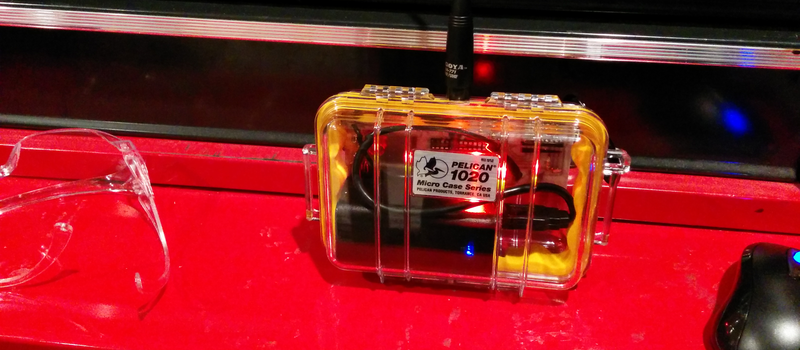Amateur radio operator [KE4FOX] wanted to build his own 2M fox hunt transmitter for use at conventions. It would be contained in a 1020 Pelican micro case and attached to a person who would walk around transmitting a signal, leaving the hams to track down the fox. The project uses a DRA818 VHF/UHF transceiver plugged into a low-pass filter combined with a hardware DTMF decoder, all controlled by an ATmega328P and powered by a 11.2 mAh battery.
[KE4FOX] also etched his own PCB, using the PCB toner transfer method, folding a sheet of transfer paper around the board to align both layers. Then he etched the board using cupric chloride. When assembling the board he realized he had made a terrible error, assuming the transceiver module’s pins went in the top layer when in fact they should have gone in the bottom layer. He solved this by soldering in the module in upside down.
He dropped the project into the 1020 and installed an SMA antenna. After he assembled the project he found out that the level shifter he used on the Arduino’s 5 V data didn’t work as expected and it was stuck at a single frequency. Something to work on for V2!
We publish a large number of amateur radio posts here on Hackaday, including fox hunting with Raspberry Pi and how to make a TDOA directional antenna.
[thanks, that Kat!]
















At least it was attached to an actual Fox this year and not a Wolf! :)
Could also work equally well for quolls…
11.2 mAh ?? It must be a hundred volts then to hold any significant charge ?
ah, the article states “11200mAh KMASHI battery”, so 11.2 Ah, and for an actual meaningful number, 42Wh according to the store listing (which would make it 3.75V).
the author explicitly quoted “level shifter”, because, you know, it’s just a freaking resistor ..
…two resistors (although no schematic is available to check why it wasn’t working, the original author does describe it as a potential divider which is a legitimate way of doing a level shift – albeit only works for down shifts, so who knows what he did for converting it back to 5v for the ATmega).
How cool is it to have a HAM call sign with the word “FOX” in it.
Very cool, I hope ;)
No schematic available = FAIL!
That is awesome! We need more HAM’s that are willing to make fun projects.
download the 73 amateur radio magazine collection it’s full of projects. get it from archive.org or bit torrent. You should be able to find an index of the articles on the web. I have it book marked on my home computer, but I’m not using it at the moment. Sorry.
There have been multiple write ups of projects similar to this. I believ that one could be found 73 amateur radio magazine collection as well in the ARRL antenna handbook, but I yet to build any version Additionally I read a very convincing article that explains why calling the antenna that’s the subject of this article a TDOA is a misnomer”. I seem to want to recall that the version in the 73 magazine collection does had an analog meter another commenter mentioned. On my want to do list is to put together the components to set up an antenna range to plot the radiation pattern of antennas.
What’s the issue with running the controller at the same voltage as the module? The module specifies 3.3 – 4.5V, 4.0VTyp. Most “5V” controllers will operate at 4V without issues as long as the speed is kept low enough. Actually getting a 4V source would be as simple as a forward biased silicon diode in series with the 5V source to get a 0.7V voltage drop for a 4.3V source. Two such diodes in series takes the output down to 3.6V.
ARDF-TXes are not the Problem. The ARDF friends and insdustrie should make a DF-RX availiable that shows the direction on a compass rose and work on the hole HF – not only for example on 80 meters. I don’t know why hf DF’s for Hams only works on some kc in the 80m Band. Mni Hams would see where the received sigs come form. All what i see in mni ARDFs applications is simple old fox hunting but not real Amateur Radio Direction Finding. What do all the friends when they have learned to find foxes ? – Mni ham bandwatch services would be happy when hundreds of hams could help finding sources and what would be that for exact measurings when 10, 20 or hundred hams triangle ?